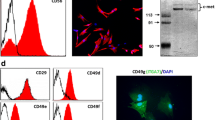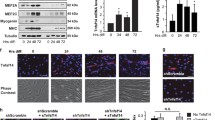Abstract
Following muscle injury, the damaged tissue and influx of inflammatory cells stimulate the secretion of growth factors and cytokines to initiate repair processes. This release of chemotactic signaling factors activates resident precursor cells and stimulates their mobilization and migration to the site of injury where terminal differentiation can occur. The three transforming growth factor-β (TGF-β) isoforms, and insulin-like growth factor-1 (IGF-1) are among the known regulatory factors released following muscle damage. We investigated the effect of recombinant active TGF-β1, -β2, -β3 and IGF-1 on C2C12 skeletal muscle satellite cell and P19 embryonal carcinoma cell terminal differentiation and migration. C2C12 myoblast fusion as well as P19 embryoid body formation and myogenic differentiation was assessed following 72 h TGF-β treatment (5 ng/ml), whereas the effect of the TGF-β isoforms on migration was determined following 7 h incubation. Our results showed that TGF-β decreases C2C12 myoblast fusion in an isoform-independent manner, whereas in the P19 cell lineage, results demonstrate that TGF-β1 specifically and significantly increased P19 embryoid body formation, but not expression of Connexin-43 or Myosin Heavy Chain. IGF-1 significantly increased migration compared to TGF-β isoforms, which, on their own, had no significant effect on the mobilization of either C2C12 or P19 cells. TGF-β isoforms decreased IGF-1-induced migration of both cell lineages. By distinguishing the factors involved in, and the molecular signals required for, myoblast recruitment during repair processes, strategies can be developed towards improved cell-mediated therapies for muscle injury.





Similar content being viewed by others
References
Alexakis C, Partridge T et al (2007) Implication of the satellite cell in dystrophic muscle fibrosis: a self-perpetuating mechanism of collagen overproduction. Am J Physiol Cell Physiol 293:C661–C669
Al-Shanti N, Stewart CE (2008) PD98059 enhances C2 myoblast differentiation through p38 MAPK activation: a novel role for PD98059. J Endocrinol 198:243–252
Andres V, Walsh K (1996) Myogenin expression, cell cycle withdrawal, and phenotypic differentiation are temporally separable events that precede cell fusion upon myogenesis. J Cell Biol 132:657–666
Avila T, Andrade A et al (2006) Transforming growth factor-beta1 and bone morphogenetic protein-2 downregulate CaV3.1 channel expression in mouse C2C12 myoblasts. J Cell Physiol 209:448–456
Bischoff R (1997) Chemotaxis of skeletal muscle satellite cells. Dev Dyn 208:505–515
Blau HM, Pavlath GK et al (1985) Plasticity of the differentiated state. Science 230:758–766
Boudoulas KD, Hatzopoulos AK (2009) Cardiac repair and regeneration: the Rubik’s cube of cell therapy for heart disease. Dis Model Mech 2:344–358
Cabane C, Englaro W et al (2003) Regulation of C2C12 myogenic terminal differentiation by MKK3/p38 alpha pathway. Am J Physiol Cell Physiol 284:C658–C666
Collins JM, Russell B (2009) Stem cell therapy for cardiac repair. J Cardiovasc Nurs 24:93–97
Cusella-De Angelis MG, Molinari S et al (1994) Differential response of embryonic and fetal myoblasts to TGF beta: a possible regulatory mechanism of skeletal muscle histogenesis. Development 120:925–933
Dhawan J, Rando TA (2005) Stem cells in postnatal myogenesis: molecular mechanisms of satellite cell quiescence, activation and replenishment. Trends Cell Biol 15:666–673
Filvaroff EH, Ebner R et al (1994) Inhibition of myogenic differentiation in myoblasts expressing a truncated type II TGF-beta receptor. Development 120:1085–1095
Habara-Ohkubo A (1996) Differentiation of beating cardiac muscle cells from a derivative of P19 embryonal carcinoma cells. Cell Struct Funct 21:101–110
Jones NC, Tyner KJ et al (2005) The p38alpha/beta MAPK functions as a molecular switch to activate the quiescent satellite cell. J Cell Biol 169:105–116
Kottler UB, Junemann AG et al (2005) Comparative effects of TGF-beta 1 and TGF-beta 2 on extracellular matrix production, proliferation, migration, and collagen contraction of human Tenon’s capsule fibroblasts in pseudoexfoliation and primary open-angle glaucoma. Exp Eye Res 80:121–134
Lafyatis R, Lechleider R et al (1991) Secretion and transcriptional regulation of transforming growth factor-beta 3 during myogenesis. Mol Cell Biol 11:3795–3803
Le Grand F, Rudnicki M (2007) Satellite and stem cells in muscle growth and repair. Development 134:3953–3957
Liapi C, Raynaud F et al (1990) High chemotactic response to platelet-derived growth factor of a teratocarcinoma differentiated mesodermal cell line. In Vitro Cell Dev Biol 26:388–392
Lim JY, Kim WH et al (2007) Involvement of TGF-beta1 signaling in cardiomyocyte differentiation from P19CL6 cells. Mol Cells 24:431–436
McBurney MW (1993) P19 embryonal carcinoma cells. Int J Dev Biol 37:135–140
McKarns SC, Letterio JJ, Kaminski NE (2003) Concentration-dependent bifunctional effect of TGF-beta 1 on immunoglobulin production: a role for Smad3 in IgA production in vitro. Int Immunopharmacol 3:1761–1774
McLennan IS, Koishi K (2002) The transforming growth factor-betas: multifaceted regulators of the development and maintenance of skeletal muscles, motoneurons and Schwann cells. Int J Dev Biol 46:559–567
Mejia-Luna L, Avila G (2004) Ca2+ channel regulation by transforming growth factor-beta 1 and bone morphogenetic protein-2 in developing mice myotubes. J Physiol 559:41–54
Mitchell PO, Pavlath GK (2001) A muscle precursor cell-dependent pathway contributes to muscle growth after atrophy. Am J Physiol Cell Physiol 281:C1706–C1715
Niesler CU (2004) Old dogmas and new hearts: a role for adult stem cells in cardiac repair? Cardiovasc J S Afr 15:184–189 discussion 189
Niesler CU, Ferguson MWJ (2001) TGF-beta superfamily cytokines in wound healing. In: SN B, Basel WS (eds) TGF-ß and related cytokines in inflammation. Birkhauser Verlag AG, Basel, pp 173–198
Nishiyama T, Kii I et al (2004) Inactivation of Rho/ROCK signaling is crucial for the nuclear accumulation of FKHR and myoblast fusion. J Biol Chem 279:47311–47319
Olson EN, Sternberg E et al (1986) Regulation of myogenic differentiation by type beta transforming growth factor. J Cell Biol 103:1799–1805
Park IH, Chen J (2005) Mammalian target of rapamycin (mTOR) signaling is required for a late-stage fusion process during skeletal myotube maturation. J Biol Chem 280:32009–32017
Qyang Y, Senyei G (2009) Regeneration of a heart cell. Yale J Biol Med 82:117–119
Robertson TA, Maley MA et al (1993) The role of macrophages in skeletal muscle regeneration with particular reference to chemotaxis. Exp Cell Res 207:321–331
Rousse S, Lallmand F et al (2001) Transforming growth factor-b inhibition of insulin-like growth factor-binding protein-5 synthesis in skeletal muscle cells involves a c-Jun N-terminal kinase-dependent pathway. J Cell Biol 276:46961–46967
Schabort EJ, van der Merwe M et al (2009) TGF-beta’s delay skeletal muscle progenitor cell differentiation in an isoform-independent manner. Exp Cell Res 315:373–384
Singla DK, Sun B (2005) Transforming growth factor-beta2 enhances differentiation of cardiac myocytes from embryonic stem cells. Biochem Biophys Res Commun 332:135–141
Skerjanc IS (1999) Cardiac and skeletal muscle development in P19 embryonal carcinoma cells. Trends Cardiovasc Med 9:139–143
Smith SC, Reuhl KR et al (1987) The role of aggregation in embryonal carcinoma cell differentiation. J Cell Physiol 131:74–84
Yaffe D, Saxel O (1977) Serial passaging and differentiation of myogenic cells isolated from dystrophic mouse muscle. Nature 270:725–727
Acknowledgments
The work was supported by the South African National Research Foundation, South African Medical Research Council, the University of Stellenbosch and the University of KwaZulu-Natal. The A4-1025 Myosin Heavy Chain antibody was obtained from the Developmental Studies Hybridoma Bank developed under the auspices of the NICHD and maintained by The University of Iowa, Department of Biology, Iowa City, IA 52242.
Author information
Authors and Affiliations
Corresponding author
Rights and permissions
About this article
Cite this article
Schabort, E.J., van der Merwe, M. & Niesler, C.U. TGF-β isoforms inhibit IGF-1-induced migration and regulate terminal differentiation in a cell-specific manner. J Muscle Res Cell Motil 31, 359–367 (2011). https://doi.org/10.1007/s10974-011-9241-1
Received:
Accepted:
Published:
Issue Date:
DOI: https://doi.org/10.1007/s10974-011-9241-1




